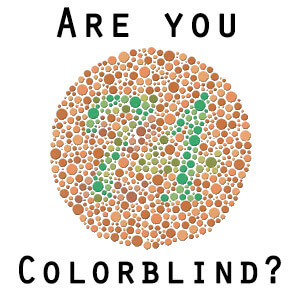Almost all people who are colorblind are able to see colors but have trouble differentiating between certain colors. Another interesting point to note is that not all colorblind people will have trouble with the same colors. A majority cannot distinguish between greens and reds in hazy light while others cannot separate yellows from blues; and a very small group of people experience a condition called monochromatism, where they are only able to see black and white.
What Causes Colorblindness?
Color blindness is a hereditary condition that is a result of the difference in how light-sensitive cells present in the retina react to different colors. These cells are known as cones and they sense wavelength of light, which then enables the retina to differentiate between colors. Colorblind people have difficulty seeing certain colors or identifying obvious differences between two shades of color under regular lighting. Most types of colorblindness is genetic and present at birth, thus colorblindness is normally diagnosed during childhood.
Signs of Colorblindness
Signs of colorblindness can differ from person to person. While some people have more serious forms of color blindness, others not experience the condition mildly. You may be colorblind and not even know about it. To help you determine this, here is a list of signs you need to look out for:
- Having trouble distinguishing between shades of green and red, blue and green, and any other colors
- Having trouble identifying colors in dim light
- Sensitivity to bright colors and lights
- Struggle reading from colored pages
- Frequent complaints of headaches or eye aches when looking at something green on a red background, or vice versa.
- Avoiding colored objects, colored games or brightly colored pictures.
Diagnosis
There are a number of tests available to identify complications associated with color blindness. The most common one is the American Optical/Hardy, Rand, and Ritter Pseudoisochromatic Test that comprises of a number of discs full of color dots of various colors and sizes. An individual with normal color vision looking at the test item will see a number clearly as it is while a colorblind person will not be able to identify the number.
Another test is the Ishihara Test, which consists of eight plates. The patient is then tested to look for numbers among the different colored dots on every test plate. Some of these plates differentiate between blue and green/red color blindness. Individuals with normal color vision see one number. On the other hand, those with green/red color deficiency perceive a different number.
Treatment
There is no absolute cure for color blindness as of yet. However, most color deficiencies are normal and can be easily adapted through easy methods.
Prevention
Like its treatment, there is no absolute way to treat color blindness especially if it has been caused by diabetes, Alzheimer’s disease, leukemia, macular degeneration, Parkinson’s disease, retinitis pigmentosa, multiple sclerosis, liver disease and mellitus. However, some forms of color blindness can be prevented by limiting drugs and alcohol use and high blood pressure medications.




